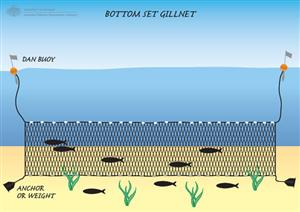Fisheries Management
Alberta supports three types of fisheries, including the sport, commercial, and domestic fisheries, described below.
The sport fishery is the largest fishery in Alberta in terms of the number of fishers and the amount of catch, with over 19 million fish caught annually (Park 2007). Almost half the fish caught are released back into lakes and rivers, due to regulations intended to protect fish populations. Types of fishing permitted with an Alberta sport fishing license include hook and line, fly fishing, bowfishing, spearfishing, minnow traps, seine nets and dip nets. The hook and line method is the most popular type of fishing.
The commercial fishery is the second largest fishery in Alberta, taking approximately 1.2 million kg of fish annually. Commercial fishing in Alberta peaked in the late 1950s and 1960s, when 7.6 million kg of fish were harvested annually (Nelson and Paetz 1992). The fishery declined due to fishing pressure as well as the introduction of the sport fishery, which took a large proportion of the catch.
Large commercial fisheries harvest lake whitefish, northern pike, lake trout, and walleye, while smaller fisheries target cisco, burbot and sucker species. Commercial fishing occurs in both the open water and winter seasons. During winter, ice fishing is carried out by stringing gillnets between paired holes in the ice. Commercial ice fishing is very popular because of higher market prices during the winter. Commercial fishery catches are sold either to the Freshwater Fish Marketing Corporation, a federal Crown corporation that supplies international markets, or directly to Albertans (AENV and ASRD 2002).
License holders in the commercial fishery primarily use gillnets to catch fish in lakes, although bait fishing is also used. The commercial fishery also includes fishing lodge operations. License holders are regulated by seasonal, area, size, and catch restrictions.
The domestic fishery is the smallest of Alberta’s fisheries, taking approximately 500,000 kg of fish annually. As in the commercial fishery, license holders primarily use gillnets. A domestic (subsistence) fishery license is issued to Aboriginal people (Metis and First Nations) and people living in remote regions who depend on fish for food. Fish caught under a domestic fishing license is solely for consumption by the licensee’s family or animals (e.g., sled dogs) and cannot be bought, sold or traded.
A separate license for each lake is required, and fishing is not permitted in flowing waters (streams and rivers) or stocked lakes. A licensee can set one gillnet up to 95 metres in length in each waterbody. License holders in the domestic fishery are regulated by seasonal and area restrictions (AENV and ASRD 2002).
Fisheries management aims to control not so much the fish as the fishers – the people who use the resource. Regulations restricting how, when, where, and how many fish are caught are set in order to maintain fish populations at a level that will sustain the sport, commercial and domestic fisheries. These regulations include:
- Closed seasons. Harvesting is permitted only during specific times of year. For example, fishing is not allowed during spawning, which allows fish to reproduce successfully.
- Area closures. Certain areas of a lake or river are closed to fishing to protect juvenile fish. This limits fishing pressure on younger fish and gives them time to reach maturity.
- Catch limits. Restrictions are set on the number of fish of a certain species that can be caught in a single day or year, to maintain the population at a consistent level.
- Size limits. Fishers are required to release fish under a certain minimum size, chosen to reflect the species' usual size at the age of reproduction. This allows fish to reach adulthood and reproduce, and hence contribute to future stocks, before being captured.
- Gear restrictions. Fish hooks are restricted to types that minimize injury and mortality of fish that are released. Gill nets are restricted to mesh sizes large enough that juvenile fish can pass through unharmed.
- Bait restrictions. Restrictions on the type of bait permitted are set both to minimize mortality of fish caught unintentionally while targeting another species, and to minimize mortality of fish that are released. For example, fish will completely swallow the hook if bait is scented, leading to increased mortality after release. It is preferable to hook a fish by the lip or mouth, causing less stress and injury.
Fishing regulations, set under the authority of the Alberta Fisheries and Fisheries Regulation acts, are specific to each species and to each waterbody, depending on its productivity and biological characteristics. Information on fishing regulations for each lake and river in Alberta, and for each game fish, are found at http://www.mywildalberta.com/Home/Fishing/Regulations.aspx. Illegal fishing or breaking regulations can lead to enforcement measures such as fines, license suspensions and jail sentences.
For more information on endangered or threatened species, please refer to the Committee on the Status of Endangered Wildlife in Canada (COSEWIC) website.









